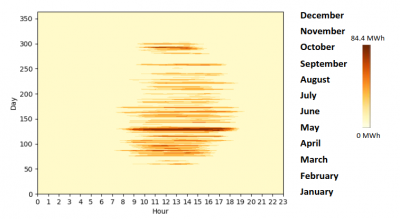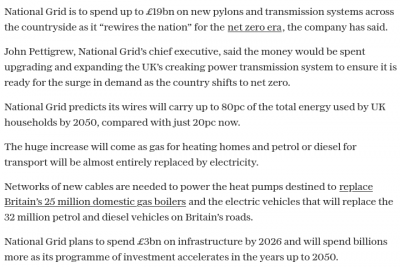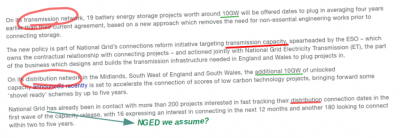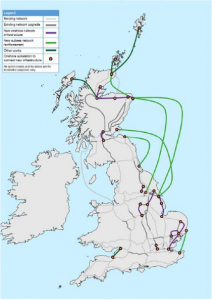Posted by: @toodlesYou sense the possibility of problems on the ‘Horizon’? Does it make you a bit fujitzi?
Nothing wrong with that software; the Post Office management were fully behind the Fujitsu contract, their processes and delivered software. Dodgy people in the Post Office, a few bad apples.
More seriously, at least the standing charge spreadsheet is open-source; visibly opaque is better than totally opaque. Not that landing a blob of code and data is particularly friendly. One DECC spreadsheet I took a look at (cost of CCGT versus other generation sources) contained a lot of assumptions which were … notable. Connection costs, carbon price too.
Posted by: @jeffI am uncomfortable about some of the basics of life like water and electricity being a different price depending on where people live.
It is a feature of electricity generation from renewable sources, that it does not happen
- in areas where the energy is wanted
- nor according to human time-frames
- nor 'fairly'
Here is an example ANM plot, provided by a DNO to a company wanting a grid connection for 100MW generation (mainly solar).
The DNO and NGET had available capacity unallocated to accept 16MW at all times.
That left a possible 84MW which couldn't be accepted under certain conditions.
Active Network Management is implemented to reject over-supply of electricity.
Without that, the line voltage would rise more than 6% above the legally-permitted threshold for that section of the grid where the connection was being proposed.
That would cause a cascade effect, with other connections automatically removing themselves from the grid due to over-voltage...
... leading to a sudden drop in supply, and risk of a grid collapse.
To alleviate the amount of electricity which is likely to be rejected, there are two main strategies:
- companies with high energy usage relocate to that area
- storage batteries closest to the point of connection will absorb the excess
What incentive could be offered other than a lower-cost electricity during that time-frame?
That issue is at the heart of Nodal Pricing.
You cannot have more renewable generation and also make it available at the same price right across the grid.
Save energy... recycle electrons!
I definitely don't support a model where a domestic customer in an identical house with an identical usage pattern pays a dramatically different amount over a year simply due to the location of the property.
Sorry I simply will never support that.
Most people can't move house and most can't afford battery. Heck only circa 4% have solar and much of that will low capacity.
There needs to be something added to the model you describe to project people.
I am not against nodal tou with something on top to stop electricity ghettos around the country.
I realise that I have an advantage in that I've had access to internal DNO data for several years.
That's allowed me plenty of time to understand how the grid works,
and how it's affected when we add solar panels, storage batteries, EV chargers or heat pumps.
The grid isn't uniform in its operation, either at the single-phase supplies to our homes,
or the locations which generate electricity from renewable assets.
Those factors are feeding into the thinking behind nodal pricing.
We already do have disparities in electricity costs.
- The standing charges are higher in regions that are furthest from the Midlands
- Standing charges are higher still in regions with greater renewable generation or more 'Offers to Connect' to the grid
- Households with prepayment meters pay more
The proposals being suggested by NGET will retain these relatively small disparities,
by placing the cost of infrastructure enhancements evenly across the country.
Would anyone like to estimate the bill for multiplying capacity by a factor of five?
Save energy... recycle electrons!
Going some way towards answering my own question about the cost of capacity upgrades to the Transmission Grid,
On 9th Nov, the Telegraph carried this announcement from NGET CEO John Pettigrew:
That needs comparing with the following story on 17th Nov from Windpower Monthly:
Great care is needed when reading press stories about National Grid's investment plans.
If the story relates to financial forecasts, then it's likely to include their infrastructure in the USA.
That's obviously of interest to its shareholders.
If the story is UK-based, then I try to check if it's referring to the National Grid group of companies, even 'though it might be specifically referencing costs being incurred on the Distribution grid, for which NGED has for licensed regions. This is a classic example riddled with ambiguities:
Save energy... recycle electrons!
You may not believe me, not many do, I was going to say £20 billion, but then decided I had better keep quiet.
@derek-m ’You say 20 Billion and I say … ‘Err.. how many billions would you like us to extract from the consumers?’ ‘Or shall we call the whole thing off?’ (Except we can’t afford to ignore the problem, it isn’t going to go away is it?!) Regards, Toodles.
Toodles, heats his home with cold draughts and cooks food with magnets.
I do hope that the aluminium smelting for the cables is powered from renewable energy😉 Regards, Toodles.
Toodles, heats his home with cold draughts and cooks food with magnets.
I don't think that £19b announcement of upgrades is the same as the "5x increase in capacity" which was being discussed at NGET's Pathway to Net Zero workshops during October.
The Telegraph article was accompanied by a map derived from this one in a Slideshow used by NG-ESO in April'23
That map is a long way short of the thicker cables and new super-grid transformers required at the 353 existing GSP sites.
It's also a map which will need to be revised as we progress towards Net Zero.
For example, consider the proposed new 400kV link between Hinkley-C and Bristol, where it crosses the Somerset Levels.
By 2050, that will need to be classed as an undersea route. 🤔
On top of the Transmission Grid upgrades and extensions, there are those to be undertaken on the Distribution Grid (132kV & below).
Any advance on £19 billion anyone?
Save energy... recycle electrons!
Where has the DT got the £19 billion figure from? The National Grid ESO page https://www.nationalgrideso.com/future-energy/pathway-2030-holistic-network-design has the printable report, and the executive summary point 3 states £21.7 billion in network upgrades. “The HND facilitates the connection of 23GW wind” which seems to imply we require £1B of investment per GW of connected wind. Also it is unclear what the headline £54B investment means; is this network plus wind farms or wind farms alone?
I guess it would be handy to know what the value flattening the peak electrical demand is.
Posted by: @chickenbigit would be handy to know what the value flattening the peak electrical demand is.
Until now, the great British public's view has been to help prevent Climate Change by installing technology (usually PV) which exports to the grid.
That has naff all effect on peak demand...
worse still, it increases losses due to phase-imbalance.
As we switch away from gas, we are losing the resilience which is inbuilt to the gas supply network.
The UK's gas pipelines probably hold sufficient energy to meet demand for at least a day without needing to feed more in.
But the electricity grid has no storage inbuilt.
The two technologies we could deploy when generation is in abundance would be
- EV chargers
- domestic storage batteries
The second issue we need to consider is the UK generation & demand statistics.
We can see last year's figures in the annual Dukes publication.
In 2022 Generation Capacity was 76.7GW
Peak Demand was 48.6GW
In May'23 Ofgem published figures showing that 280GW of electricity had "offers to connect" but were unable to do so pending grid upgrades.
In broad terms, the UK has plenty of renewable generation to meet likely demand for at least a decade, even assuming that we all switch to EVs.
So @chickenbig is rightly stating that flattening the peak is important...
... in fact, it's probably more important than increasing grid capacity.
National Grid may not agree with my assessment of course. 😘
They're a commercial company.
It's to their benefit to have an oversized UK grid with vast surpluses of electricity which can be exported at a profit.
That "headline £54 billion investment", which @chickenbig mentioned, is closer to my estimate of the grid upgrades required across both Transmission and Distribution.
Let's take half of that £54b and instead invest it in storage batteries for the 3 million homes which are Social Housing. That's 10% of UK housing stock.
For £9,000 per house they could have a 14kWh capacity battery operating off-grid.
A "Smart Inverter" would recharge the battery from the grid when there is excess generation and lower prices.
That can be detected automatically. It doesn't need any central control system.
What do you think that would do to the 48.6GW demand peak?
Would it sufficiently flatten the peak that we no longer need the majority of the other planned grid upgrades?
Save energy... recycle electrons!
- 26 Forums
- 2,418 Topics
- 54.8 K Posts
- 305 Online
- 6,098 Members
Join Us!
Worth Watching
Latest Posts
-
RE: Ecodan Pump Issues… Circulation pump turns off when heat pump compressor turns off
@ashp-bobba I agree. I think I'll simplify the system j...
By Patch321 , 3 hours ago
-
Is it normal to use power from the grid when running off the battery?
I've recently had a Solis hybrid inverter fitted, with ...
By JohnnyB , 7 hours ago
-
RE: Recommended home battery inverters + regulatory matters - help requested
@jamespa having read through this thread I will add a f...
By JohnnyB , 8 hours ago
-
RE: Reliable, easy to use home battery options
I have just had a my inverter and battery installed, ab...
By JohnnyB , 9 hours ago
-
RE: Setback savings - fact or fiction?
Our system is radiators, large ones and now with DIY fa...
By RobS , 11 hours ago
-

RE: Samsung E101 Error Message and my ASHP Efficiency
@johnnyb amazing that the our forum is serving its purp...
By Mars , 11 hours ago
-
Best option for controller upgrade? - Grant Aerona
Fairly new heat pump owner - Grant Aerona 3 10kw - and ...
By Topher , 11 hours ago
-
RE: How to use my Hanchu battery storage for home without it feeding back into the grid?
@countryman-helmsley Is the Hanchu ESS app definitely ...
By SKD , 12 hours ago
-
RE: Installer Fitted 9kW Instead of 11kW Heat Pump and Changed MCS Paperwork - What do I do?
@jamespa thank you. I think I'll go for 59 at -8, we ca...
By MairiA , 13 hours ago
-
RE: Daikin Wireless Thermostat
@toodles Yes. British Gas seems to have done an exce...
By Bash , 13 hours ago
-

RE: Is my Samsung gen6 outside air temp sensor missing a sheath/sleeve?
@papahuhu Mine is similar. Is your house not getting...
By bontwoody , 15 hours ago
-

Just a brief update to keep things transparent. Secti...
By DREI , 15 hours ago
-
RE: Ideal HP290 14kW ASHP - how to optimise
Sorry forgot about the three choices. It’s the 2nd one ...
By Davesoa , 16 hours ago
-

I continue to receive emails from homeowners sharing he...
By Mars , 17 hours ago
-

RE: Water outage in the the south-east
We think alike @editor ! All those bottles (and I expec...
By Toodles , 17 hours ago
-

RE: Say hello and introduce yourself
@mrfield, welcome to the forums. Please go here and ...
By Mars , 19 hours ago
-
RE: Octopus Cosy Heat Pump Owners & Discussion Thread
I did not hear back from the tech team. (Assume they ar...
By swwils , 21 hours ago
-
RE: Advice for a novice on Mitsubishi Ecodan 6kW
In the Home Assistant firmware the data points...
By F1p , 1 day ago
-
RE: GSHP WOES! Midland based engineer recommendations?
@johnbroome if it is not the pressure in the expansion ...
By ASHP-BOBBA , 1 day ago
-
So I hear the export MPAN that UKPN assigned should be ...
By Batpred , 2 days ago










